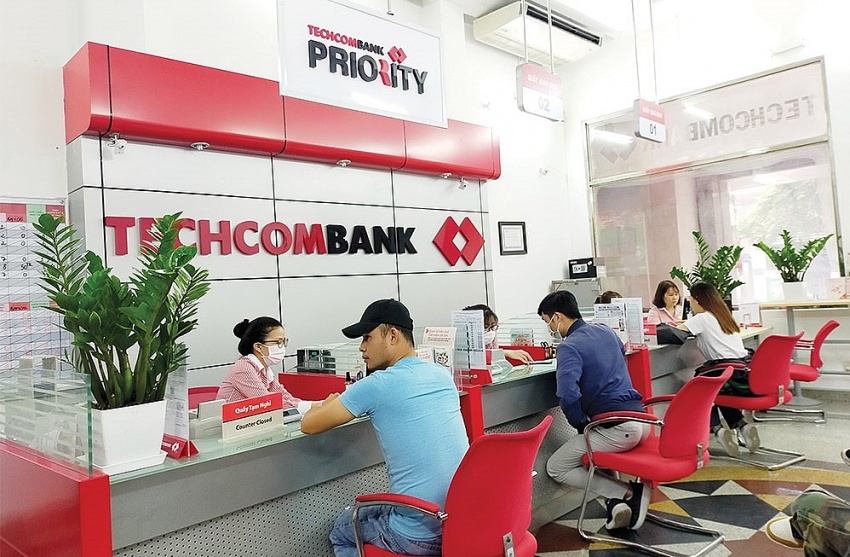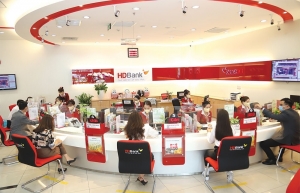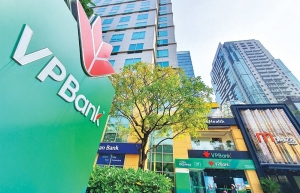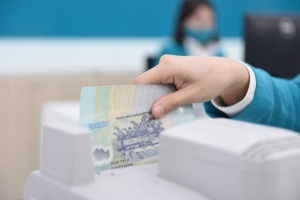Larger lenders in good growth stead
According to financial reports from 28 joint-stock commercial banks published last week, the total post-tax profit for Q1 reached approximately VND72 trillion ($3 billion), marking a 9.6 per cent increase compared to the same period last year.
 |
| Techcombank was one of the leaders in the Q1 profit rankings, photo Le Toan |
The top 10 banks with the highest post-tax profits in Q1 remained largely unchanged, featuring familiar names such as Vietcombank, BIDV, Techcombank, and VietinBank. However, the rankings within this group saw some notable shifts.
Last week, VPBank Securities (VPBankS) released an updated report on the banking sector’s outlook for 2024, anticipating a marked recovery in the latter half of the year. According to VPBankS, pre-tax profits for listed banks are projected to grow by 15 per cent on-year, reaching approximately VND293.65 trillion ($12.24 billion), assuming the State Bank of Vietnam (SBV) does not raise interest rates in 2024 and major banks utilise 90 per cent of their allocated credit room from the beginning of the year.
“Overall, larger banks are expected to experience stronger positive credit growth compared to the previous year, while smaller banks may struggle to compete and therefore exhibit less robust growth,” VPBankS reported.
However, due to unfavourable market conditions, the sector’s return on equity is projected to decrease from 19.8 to 15.9 per cent, and return on assets from 1.5 to 1.4 per cent, from last year to this year. VPBankS anticipates that in 2024, both ratios could rebound with higher profit growth compared to the previous year, and capital growth is expected to slow down relative to recent years.
Despite these projections, asset quality remains a concern, and non-performing loans (NPLs) have been on the rise for several years, VPBankS stated. The current NPL ratio stands at 1.9 per cent, up from 1.7 per cent in 2022, indicating a 12 per cent increase. VPBankS highlighted this as a significant issue.
Meanwhile, the SBV recently sought public comments on draft amendments to Circular No.02/2023/TT-NHNN, which includes provisions for restructuring debt repayment terms and maintaining debt classification to support customers facing difficulties. This extension is proposed to last until the end of 2024, rather than ending in June.
“This also means that non-performing loans continue to be ‘concealed’, and if banks are unable to recover debts when Circular 02 expires, bad debts could rise further,” VPBankS cautioned. The rising NPLs have been a recurring concern raised by credit institution leaders since the beginning of the year.
A survey by the SBV in late May indicated that the overall risk profile of customer groups is expected to increase in Q2, although at a slower rate. While credit institutions noted a slight increase in NPLs in Q1, the anticipated trend for year-end was a mild decrease. Positively, the decline has narrowed significantly compared to Q4 of 2023, and credit institutions are hopeful for a reduction in NPLs in Q2 this year.
On the other hand, Mirae Asset Securities believes that the banking sector has exhibited more positive price movements compared to the broader market, reflecting better recovery prospects for this group relative to many other sectors.
“However, the continuous net withdrawal by foreign investors, due to various external factors, has impacted the potential price increase in banking stocks. This is particularly significant given the high proportion of foreign ownership in the banking sector,” the brokerage said. “In the short term, exchange rate pressure and inflation may prompt the SBV to intervene by absorbing excess liquidity from the economy, which could affect the overall short-term outlook for the stock market.”
Despite the uncertainties surrounding the banking sector, Mirae Asset said there are still many investment opportunities within this group.
“New changes in the revised Land Law indicate that market entry barriers for new real estate companies are becoming more challenging,” it noted.
As a result, banks with close partnerships with real estate developers are expected to have an advantage in credit growth for personal customers (home loans) in both the short and medium term, including Techcombank, HDBank, MB, and VPBank.
“The potential for interest rate hikes is expected to lead to higher credit costs in the coming quarters. However, banks that have already adapted to high credit costs since 2020, such as VPB and VIB, are anticipated to experience less volatility,” Mirae Asset stated. “Additionally, these two banks benefit from low profit bases and relatively attractive valuations, presenting noteworthy investment opportunities.”
 | Lenders integrate a greener perspective Some major Vietnamese banks are intensifying their focus on sustainable practices by dedicating significant funds to renewable energy projects and reducing interest rates for eco-friendly initiatives. |
 | Lenders to benefit from refinements A new strategic regulatory reform by Vietnam’s central bank aims to balance risk management with robust credit expansion, particularly in sectors pivotal to the country’s economic growth. |
 | Lenders increase provisioning to protect against bad debt Deputy Governor of the State Bank of Vietnam (SBV) Dao Minh Tu has revealed that the central bank has greenlit a six-month extension of the debt rescheduling policy according to Circular No.02/2023/TT-NHNN. |
What the stars mean:
★ Poor ★ ★ Promising ★★★ Good ★★★★ Very good ★★★★★ Exceptional
Related Contents
Latest News
More News
- Tax sector wraps up 2025 and sets priorities for next year (December 25, 2025 | 14:00)
- A tipping point for digital and hybrid wealth management in Vietnam (December 23, 2025 | 13:33)
- $250 million deal targets women-owned SMEs, sustainable agriculture (December 22, 2025 | 17:40)
- Stock market posts resilient 2025 performance (December 19, 2025 | 18:17)
- Citi Vietnam receives 2025 AmCham CSR recognition (December 19, 2025 | 16:35)
- As global green supply chain reshapes, will Vietnam be left behind? (December 19, 2025 | 08:00)
- Banks gear up for massive capital increases (December 18, 2025 | 17:04)
- Securing capital and efficiency for Vietnam’s 2026-2030 growth ambitions (December 17, 2025 | 10:00)
- Energy sector in need of blended finance mechanisms (December 17, 2025 | 09:00)
- Vietnam still has room to mobilise capital for sustainable growth (December 17, 2025 | 08:57)

 Tag:
Tag:





















 Mobile Version
Mobile Version